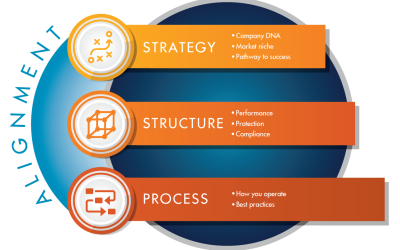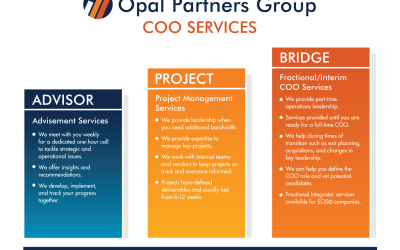Whether you mean to or not, you are constantly communicating to your employees. You must be intentional about the messages they receive. I learned this from dogs and children, and our grown-up employees are just as observant. My dog observes what I do and modifies his...
INSIGHTS
Thoughts on strategy and operations from a Fractional COO
Management and culture make a difference
If you don’t believe that management and culture make a difference in your company’s success, you are wrong. Let me give you an example from Toyota that I learned about from a recent podcast. When Toyota was making their first moves to manufacturing in the US, they...
Some part of your business isn’t working
Some part of your business isn’t working. The hard part is identifying where the problem lies. You may know that your products may need to be refreshed, or that you need to invest in new software to support critical functions. Sometimes the problem is more elusive. ...
Act now
The hill was more than I bargained for. It was a struggle and I should have realized earlier that is was time to act now. I had all kinds of excuses: the weather was bad. I didn’t have time. It could wait another day. I had other plans. No, I wasn’t hiking up a...
Facing change
Sometimes you initiate change, and sometimes it is forced on you. Regardless of how you got there, you must deal with it. Facing change isn't always easy or wanted. Key employees leave. New technology disrupts the market. Your exit strategy or timeline changes. ...
Do you feel stuck?
Do you feel stuck? On one hand, you've been "all in" on building your business for a long time. You need time to do those things that only you can do, or you need to devote time to family or passions outside the business. You can't continue to do it all. On the other...
Learning about business from sports
On a Saturday morning walk, I witnessed something so common we ignore the lessons it teaches – a tennis match. On the face of it, it was nothing extraordinary. Three matches, three courts, and twelve players. No umpire, no coach, no scoreboard, and no announcer. ...
A failure of leadership
“What took you so long?” It was the worst feedback I ever received in my career. And it came from someone I managed, not my manager. I had failed to act. I failed to lead. I didn’t make the tough decision. I thought I was being nice. I thought I was getting...
Organizational Clarity is Critical
A lack of organizational clarity may be the root of many of the issues you face. Without organizational clarity, you have no accountability. Team members don’t know what is expected. They don’t know how their performance will be judged. They don’t know what the...
It’s time to change – Your Business 2.0
The Brady Bunch sang "when it's time to change, then it's time to change, from who you are into what you're gonna be." How is your business going to change AFTER the COVID-19 crisis and things begin to look a little more normal? You've been forced to learn, adapt, and...
A Prayer for our Nation
The coronavirus and its effects on our communities are evident all around us. We are awash in information and misinformation, given opinions that run from wildly pessimistic to optimistic, and left confused and not knowing who or what to believe. We don’t have to be...
The 4 C’s of Accountability
Do you wish you had more accountability in your organization? Business owners commonly express the need for more accountability when talking about their challenges. I have found leaders actually mistake other issues for a lack of accountability. Leaders build...
The power to influence or direct behavior or events
People like to be in it, no one likes to be called out of it, and Janet Jackson even wrote a song about it. What is it? Control. It’s natural to want control - to be in command of your life, your destiny, your job, your customers. And we all realize that there are...
They’re watching you
It’s true- you have influence. People notice your actions and your words. If you are a leader – at work, at home, in the community – in any capacity, people do pay attention to what you do and what you say. Every interaction or observation can leave a lasting...
Don’t be afraid of accountability
It is not unusual for business owners to tell me they want more accountability in their organizations. My first question for them is usually something like “what’s keeping you from holding people accountable?” I know it is easier said than done. Driving...
Are your employees engaged?
According to a Gallup report, only 34% of US employees are actively engaged in their jobs. Gallup defines "engaged" as "involved in, enthusiastic about and committed to their work and workplace." What about the other 66%? 13% are "actively disengaged," and a...
Creating Clarity
It's true - inquiring minds do want to know, if you are talking about the people who make your business run every day. They crave clarity. I was reminded of this working with a client recently on some operational challenges. The client, who uses EOS, said during our...
The Silver Bullet
Are you searching for a software solution that will transform your business? Or maybe your company is just one great hire from kicking it into another gear. Perhaps you are on the verge of implementing a new program rally your team. You are hoping for a silver bullet....
Culture – policed or created?
Today I read an article that called HR the department responsible “for policing personnel actions and culture.” That struck me as odd. Corporate culture shouldn’t be policed. Leaders model and nurture it; employees create it. Culture is the environment and personality...
Growth: The Good, the Bad, and The Ugly
It’s a safe bet that if you do a quick internet search on business priorities that increasing topline revenue, improving sales performance, and increasing company value will show up in the top results. Growth matters. To misquote Gordon Gekko: growth is good. Growth...
Lessons from a reality show
I’ll admit I’m a fan of survival reality shows like Survivorman and Naked and Afraid. These shows are entertaining to watch and you can learn lessons from reality shows too. I find The History Channel’s Alone to be one of the more engaging ones. The contestants...
Gain more by giving away
“I’m too busy.” “I don’t have time.” “I have too many priorities fighting for my attention.” Sound familiar? In times where we are expected to do more with less and where immediate isn’t fast enough, we’ve all felt that way. It’s worse when we think we must do it all...
Are you limiting your team’s success?
If you are a business owner or leader of a team, repeat after me: "It's all my fault." Wait, what? Yes, the buck stops with you. You are ultimately responsible for your team's success. Let's assume that you have hired a great team. Bright "go-getters" who want nothing...
Leaders lead…people
Leaders of all kinds - from CEOs to department managers to Little League coaches, in businesses, non-profits, and volunteer organizations - take on responsibilities that not everyone wants. Most leaders step into those roles because they feel called to lead. It's...
Your business is growing….why don’t you feel like you are winning?
Your business is growing. You've got a great product or service, you know your customers, and you've assembled a stellar team. But something has changed. Profitability has slipped, tasks take longer to complete than they should, or your team is frustrated. What's...
Ready to take your first step towards breaking through to a new level of performance?
Then let’s hop on a call and see if System & Soul is right for you.
























